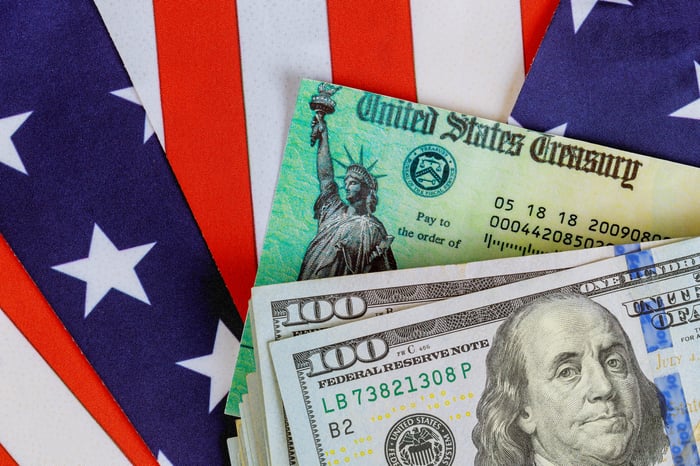For the past three months, the U.S. economy has been tested like never before. The coronavirus disease 2019 (COVID-19) pandemic has pushed more than 39 million people out of work over a nine-week stretch, with the official unemployment rate likely to rival, and perhaps even surpass, the all-time peak of 25% set during the Great Depression.
Knowing full-well the scope of the economic damage that would be caused by shutting down nonessential businesses in an effort to stem disease transmission, Congress passed and President Trump signed the Coronavirus Aid, Relief, and Economic Security (CARES) Act into law more than two months ago, on March 27.

Image source: Getty Images.
The CARES Act hasn't done nearly enough for most Americans
The $2.2 trillion CARES Act is the costliest piece of relief legislation ever passed on Capitol Hill. It set aside $100 billion in funding for hospitals, apportioned $500 billion for distressed industries, such as the airlines, directed nearly $350 billion toward small business loans, and allocated $260 billion to expand the unemployment benefits programs. Those who qualify will receive an extra $600 a week in unemployment benefits through July.
But there's little question that the CARES Act is going to be remembered for the $300 billion in direct payouts to the American public and seniors. According to the Internal Revenue Service (IRS), more than 140 million Economic Impact Payments (as these stimulus payouts are officially known) totaling $239 billion had been disbursed, as of May 18.
At their maximum, these stimulus payments can total $1,200 per individual and up to $2,400 for a couple filing jointly. Additionally, qualifying dependents under the age of 17 can add $500 (each) to what a parent or household will receive.
While there's little doubt that these payouts were necessary, with tens of millions of Americans suddenly losing their jobs, they haven't done nearly enough to bridge the financial maelstrom that most folks are facing. An April 22 Money/Morning Consult survey found that 74% of the 2,200 respondents questioned either already spent or were expected to spend their stimulus money in four weeks or less. This is a problem, considering that the U.S. economy isn't going to just pick right up where it left off.
Suffice it to say that pressure is mounting on lawmakers to come up with a second round of direct stimulus to help those adversely affected by COVID-19. The good news is that the White House now appears receptive to the idea.

Image sources: Getty Images.
The 3 biggest changes to expect with a second stimulus check
Make no mistake about it -- if and when the next round of stimulus payouts is passed, it will almost certainly feature three key changes.
1. Aggregate payouts will likely be larger
The first difference most families and some individual taxpayers are likely to see is a larger aggregate payout than what was received via the CARES Act. Whether that's done as a one-time payment or some form of ongoing stimulus is unclear. What's pretty obvious from the more than half-dozen stimulus proposals that have made the rounds on Capitol Hill over the past two months is that most call for a larger cumulative payout to Americans and seniors.
For example, the Emergency Money for the People Act, introduced by Rep. Tim Ryan (D-Ohio) and Rep. Ro Khanna (D-Calif.), calls for $2,000 monthly payouts to individuals and $4,000 monthly payments to couples filing jointly. Additionally, qualifying dependents (limit three) would add $500 each to what a parent or household would receive. Further, whereas stimulus payouts stop for the CARES Act at $99,000 and $198,000 in adjusted gross income, respectively, for individuals and married couples, the Emergency Money for the People Act allows individuals and couples with incomes below $130,000 and $260,000 to net a payout.
Aside from the Emergency Money for the People Act, the Automatic Boost to Communities Act, introduced by Rashida Tlaib (D-Mich.) and Pramila Jayapal (D-Wash.), and the Monthly Economic Crisis Support Act, brought forward by Senators Bernie Sanders (I-Vt.), Kamala Harris (D-Calif.), and Ed Markey (D-Mass.), both call for $2,000 monthly payouts for eligible individuals, and $4,000 for couples filing jointly.

Image source: Getty Images.
2. Limitations on dependents will be reduced or removed in their entirety
A second big change to expect is more lenient definitions being used to describe who qualifies as a dependent.
As you may recall, the CARES Act specifically denoted a qualifying dependent as someone aged 16 and under. This meant high school seniors living at home with their parents, college-age students who were dependents, and senior citizens claimed as dependents by a family member, friend, or guardian, couldn't qualify for the $500 kicker added to what a parent or household would receive. That may change if and when lawmakers pass a second round of stimulus.
For instance, the Health and Economic Recovery Omnibus Emergency Solutions Act, which is better known as the HEROES Act, completely removes the age limitations on who qualifies for the $1,200-per-dependent kicker associated with this proposal. Although the HEROES Act caps the number of dependents at three, it nevertheless means that any dependent claimed on an individual's or household's federal tax filing (up to the limit of three) would qualify a parent or household for an extra $1,200.
The Emergency Money for the People Act, the Automatic Boost to Communities Act, and the Monthly Economic Crisis Support Act also remove these age restrictions on dependents.

Image source: Getty Images.
3. Payouts will be considerably more efficient
Maybe the most important thing you need to hear is that if and when another round of stimulus payments is passed on Capitol Hill, the IRS and Treasury Department should be able to get eligible recipients their payments considerably faster than they have under the CARES Act.
As some of you likely know from firsthand experience, getting your stimulus check has been easier said than done. Millions of Social Security beneficiaries have waited weeks longer than expected for their stimulus payouts to hit their bank accounts. Also, if taxpayers have used a tax-preparation service in recent years and received a refund, their payout was likely sent to a temporary account set up by their preparer. This delay will likely result in these folks receiving a paper check by snail mail.
Assuming another round of stimulus becomes a reality, the good news is the IRS now has far more bank accounts on file than it did three months ago. This should mean that close to 90% of all eligible Americans can receive a future stimulus payment by direct deposit.
Additionally, the Treasury and IRS may lean on prepaid cards to expedite future stimulus disbursements. These cards work like a debit card, but would allow the recipient to withdraw cash, if needed.
Though nothing is set in stone, don't count on a second round of stimulus looking anything like the CARES Act.






